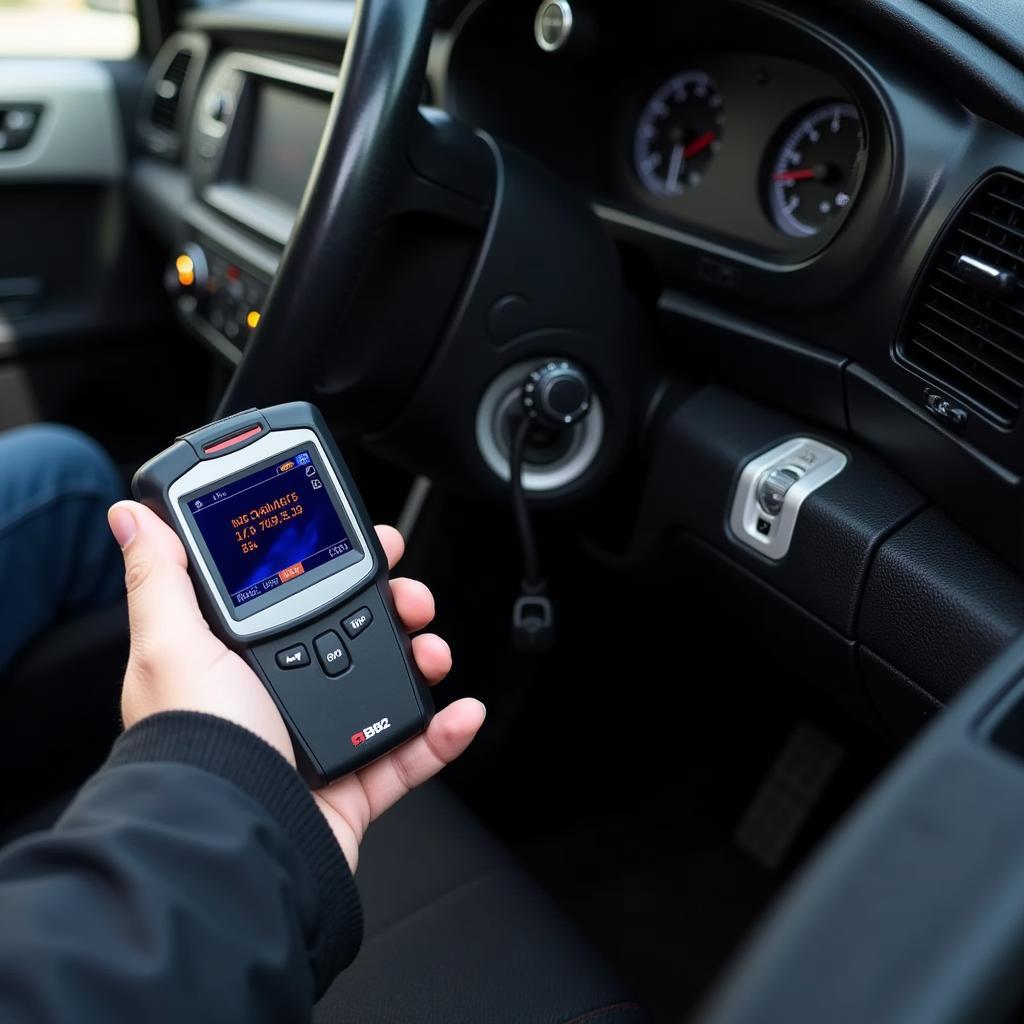A “Device Check Car Problem” is often the first step in diagnosing a vehicle issue. Modern vehicles are increasingly reliant on complex electronic systems. When problems arise, it can be difficult to pinpoint the root cause without the proper tools and knowledge. This comprehensive guide will equip car owners, mechanics, and automotive enthusiasts with the information needed to understand and utilize car diagnostic devices effectively.
Understanding Car Diagnostic Devices
Automotive diagnostic devices, or car code readers, are essential tools that interface with a vehicle’s onboard computer system – the Engine Control Unit (ECU). The ECU continuously monitors various sensors throughout the vehicle, collecting data on engine performance, emissions, safety systems, and more. When a malfunction is detected, the ECU stores a corresponding Diagnostic Trouble Code (DTC) in its memory.
 OBD2 Scanner Connected to Car
OBD2 Scanner Connected to Car
Car diagnostic devices allow you to:
- Retrieve DTCs: By accessing the ECU’s memory, these devices can read the stored DTCs, providing valuable insight into the nature of the problem.
- Clear DTCs: After addressing the underlying issue, diagnostic devices can erase the DTCs from the ECU’s memory, resetting the “Check Engine” light.
- Display Live Data: Many advanced scanners offer real-time data streams from various sensors, allowing you to monitor engine parameters, emissions readings, and other crucial information while the engine is running.
Types of Car Diagnostic Devices
There are several types of car diagnostic devices available, each offering varying levels of functionality and complexity:
- Basic Code Readers: These entry-level devices can retrieve and clear basic DTCs. They are affordable and user-friendly, making them suitable for DIY car owners.
- Advanced Scan Tools: Professional mechanics often utilize advanced scan tools that provide comprehensive diagnostic capabilities, including live data streaming, bi-directional control over actuators, and access to manufacturer-specific codes.
- Smartphone Apps: With the rise of smartphone technology, various apps can connect to your vehicle’s OBD-II port via Bluetooth or Wi-Fi, offering a range of diagnostic functions directly on your phone.
Common Car Problems Diagnosed with Devices
Car diagnostic devices can help identify a wide range of issues, including:
- Engine Problems: Misfires, reduced power, poor fuel economy, and unusual noises can often be traced back to engine-related faults.
- Transmission Issues: Slipping gears, rough shifting, and transmission warning lights can indicate problems with the transmission control module or other components.
- Emissions System Faults: Diagnostic devices can pinpoint issues with the oxygen sensors, catalytic converter, and other emissions-related components.
- Brake System Problems: ABS light illumination, unusual braking behavior, and faulty sensors can be diagnosed using a car diagnostic device.
- Airbag System Malfunctions: Airbag warning lights often indicate problems with sensors, wiring, or the airbag control module itself.
Interpreting Diagnostic Trouble Codes (DTCs)
DTCs are alphanumeric codes that follow a standardized format:
-
The first character indicates the system:
- P: Powertrain (engine, transmission, emissions)
- B: Body (airbags, power windows, central locking)
- C: Chassis (ABS, traction control, suspension)
- U: Network & Communication (ECU communication errors)
-
The second character indicates whether the code is generic or manufacturer-specific:
- 0: Generic (applies to all OBD-II compliant vehicles)
- 1: Manufacturer-specific
-
The remaining four characters pinpoint the specific problem area.
It’s essential to note that DTCs provide a starting point for diagnosis, not a definitive answer. Further investigation is often required to determine the exact cause of the problem.
Tips for Using Car Diagnostic Devices Effectively
- Invest in a reputable device: Choose a device from a well-known brand with positive reviews and a proven track record.
- Consult your vehicle’s repair manual: Each vehicle model may have specific procedures or precautions for using diagnostic equipment.
- Don’t jump to conclusions: DTCs provide clues, not conclusive answers. Use your knowledge and experience, or consult a qualified mechanic for accurate diagnosis and repair.
- Keep your device updated: Manufacturers regularly release software updates for diagnostic devices to ensure compatibility with the latest vehicle models and technologies.
Conclusion
“Device check car problem” solutions have become indispensable in the world of automotive repair and maintenance. Understanding how to use these devices effectively can empower car owners and mechanics to diagnose and address issues efficiently, saving both time and money. Remember, while car diagnostic devices offer valuable insights, they should be used in conjunction with your knowledge, experience, and the guidance of a qualified mechanic when necessary.
If you’re facing persistent car trouble or require expert assistance, don’t hesitate to reach out to the professionals at Autotippro.
Contact AutoTipPro:
- Phone: +1 (641) 206-8880
- Office: 500 N St Mary’s St, San Antonio, TX 78205, United States
Frequently Asked Questions (FAQs)
-
Can I use any diagnostic device on my car?
Most cars manufactured after 1996 in the United States are equipped with the OBD-II standard, allowing compatibility with a wide range of diagnostic devices. However, certain manufacturer-specific codes may require specialized equipment.
-
Will using a car diagnostic device void my car’s warranty?
Using a diagnostic device to read and clear codes will not void your warranty. However, attempting repairs beyond your skill level could potentially affect warranty coverage.
-
How often should I check my car for diagnostic trouble codes?
It’s generally recommended to check for codes whenever the “Check Engine” light illuminates or if you experience unusual vehicle behavior.
-
Can a car diagnostic device tell me how much a repair will cost?
Diagnostic devices can identify problem areas but cannot provide cost estimates for repairs. Repair costs vary depending on the severity of the issue, labor rates, and parts availability.
-
What should I do if the “Check Engine” light comes on after clearing codes?
If the “Check Engine” light reappears shortly after clearing codes, it indicates a persistent issue requiring further investigation.




Leave a Reply